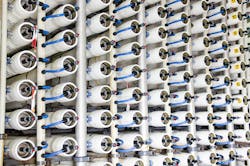Freshwater supply challenge stimulates innovation in RO desalination
A recent analysis from Frost & Sullivan finds that the increase in freshwater demand for human consumption and industrial usage while freshwater resources decline is compelling governments worldwide to investigate innovative technological solutions to access freshwater. As a result, seawater reverse osmosis (SWRO)-based desalination technology has gained industry interest as it can desalinate seawater in a potentially cost-effective manner. The research highlights the emerging innovations and latest developments in SWRO desalination technologies and the respective technology readiness levels.
"Rising concerns over climate change have set off alarms regarding the future of water supplies, driving the demand for sustainable technology solutions to ensure a reliable freshwater supply," said Kartikey Shukla, Technical Insights Research Analyst at Frost & Sullivan. "Further, rapid innovation, regulatory amendments, and consumer demand for eco-efficient technology solutions have spurred a structural transformation across the reverse osmosis seawater desalination industry."
Shukla added: "Technologies such as blockchain are likely to be integrated with reverse osmosis seawater desalination, and this leads residential and commercial users to adopt modular or small-scale desalination plants and use a blockchain-based trading platform to efficiently trade fresh drinkable water amongst the producer and consumer. Going forward, the introduction of blockchain and big data related to small-scale or modular desalination plants can also be useful in making data-driven decisions regarding the need for large-scale reverse osmosis seawater desalination plants."
Technology convergence provides an immense landscape of reverse osmosis seawater desalination opportunities, thereby presenting tremendous growth prospects for market participants, including the following:
- Researchers are encouraged to leverage nanotechnology to develop thin-film membranes that can function at low-pressure conditions to decrease the desalination process energy requirements.
- Vendors can leverage the developments in artificial intelligence (AI) and machine learning technologies to ascertain the composition of materials for the construction of reverse osmosis membranes with desirable properties, such as biofouling resistance and high durability.
- Private participants in the water desalination sector should collaborate with research institutes involved in research and development (R&D) for SWRO desalination.
For further information on this analysis, Radical Innovations in Reverse Osmosis Seawater Desalination, go to http://frost.ly/54g
